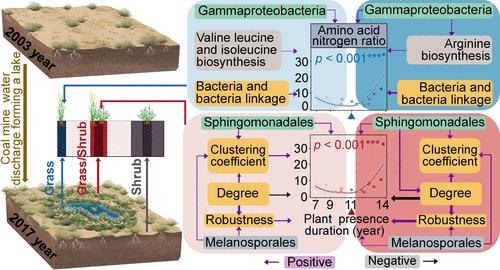Multiscale Regulation of Rhizosphere Microorganisms on the Spatiotemporal Variation of Soil Amino Acid Nitrogen During Plant Succession: A Case Study from the Desert Riparian Ecosystem
IF 11.3
1区 环境科学与生态学
Q1 ENGINEERING, ENVIRONMENTAL
引用次数: 0
Abstract
Riparian zones in deserts are critical for water purification, habitat, and soil conservation, but most studies focus on vegetation zones without long-term monitoring, hindering the comprehensive assessment of their long-term benefits. This study on Yuangeda Lake in northwestern China’s desert used spatiotemporal substitution to convert soil spatial heterogeneity into a temporal gradient, analyzing soil properties across vegetation zones formed by lake expansion and microbial impacts on amino acid nitrogen. Results showed that rhizosphere soil amino acid nitrogen was higher in grass (Agropyron cristatum L. Gaertn.) and grass/shrub mixed (A. cristatum and Artemisia desertorum Spreng.) areas than in shrub areas (A. desertorum). As plant communities persisted, a distinct threshold in rhizosphere soil amino acid nitrogen emerged at approximately 11 years. Rhizosphere bacterial and fungal specific taxonomic units, microbial co-occurrence network topologies, and amino acid nitrogen-related bacterial functions differed between grass/grass-shrub-mixed and shrub areas, linked to plant community duration. Bacteria dominated amino acid nitrogen formation in grass areas, while bacteria and fungi contributed in the grass/shrub mixed area. Overall, water inflow promoted soil amino acid nitrogen accumulation, with microbial contributions varying by plant community duration. This study supports desert riparian soil restoration and management, advancing our understanding of amino acid nitrogen in the nitrogen cycle.

植物演替过程中根际微生物对土壤氨基酸氮时空变化的多尺度调控——以荒漠河岸生态系统为例
沙漠河岸带对水净化、生境和土壤保持至关重要,但大多数研究集中在植被带,缺乏长期监测,阻碍了对其长期效益的全面评估。以元大湖为研究对象,采用时空替代法将土壤空间异质性转化为时间梯度,分析了湖泊扩张形成的植被带土壤性质和微生物对氨基酸氮的影响。结果表明:禾草区(Agropyron cristatum L. Gaertn.)和草灌木混交区(A. cristatum and Artemisia desertorum春)根际土壤氨基酸态氮含量高于灌木区(A. desertorum);随着植物群落的持续存在,根际土壤氨基酸氮在大约11年时出现一个明显的阈值。草木混交区和灌木混交区根际细菌和真菌特异性分类单位、微生物共生网络拓扑结构和氨基酸氮相关细菌功能存在差异,与植物群落持续时间有关。草原区氨基酸氮的形成以细菌为主,而草/灌木混交区则以细菌和真菌为主。总体而言,进水促进了土壤氨基酸氮的积累,微生物的贡献随植物群落持续时间的不同而不同。本研究为荒漠河岸土壤的恢复与管理提供了支持,促进了我们对氮循环中氨基酸态氮的认识。
本文章由计算机程序翻译,如有差异,请以英文原文为准。
求助全文
约1分钟内获得全文
求助全文
来源期刊

环境科学与技术
环境科学-工程:环境
CiteScore
17.50
自引率
9.60%
发文量
12359
审稿时长
2.8 months
期刊介绍:
Environmental Science & Technology (ES&T) is a co-sponsored academic and technical magazine by the Hubei Provincial Environmental Protection Bureau and the Hubei Provincial Academy of Environmental Sciences.
Environmental Science & Technology (ES&T) holds the status of Chinese core journals, scientific papers source journals of China, Chinese Science Citation Database source journals, and Chinese Academic Journal Comprehensive Evaluation Database source journals. This publication focuses on the academic field of environmental protection, featuring articles related to environmental protection and technical advancements.
 求助内容:
求助内容: 应助结果提醒方式:
应助结果提醒方式:


